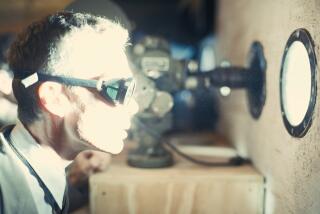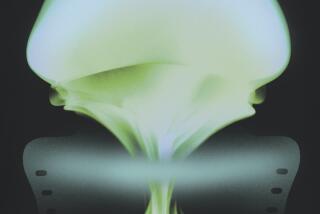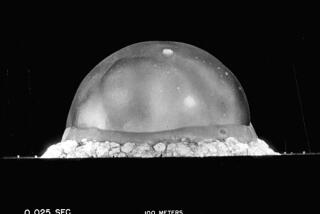Victor Weisskopf, 93; Nuclear Physicist on Manhattan Project
Victor F. Weisskopf, a nuclear physicist who worked on the Manhattan Project and then spent much of the rest of his life warning against nuclear weapons, has died. He was 93.
Weisskopf, professor emeritus of physics at the Massachusetts Institute of Technology, died Sunday night at his home in Newton, Mass. The cause of death was not announced.
A philosopher, gifted writer and international statesman of science, Weisskopf was well-regarded for his work in three fields of theoretical physics: quantum electrodynamics, nuclear physics and particle physics.
“[He] was a giant of 20th century physics, a great spokesman for peace, for the welfare of humanity and the beauty of physics,” said Robert L. Jaffe, director of the MIT Center for Theoretical Physics.
“He had an incredible knack for explaining physics in a simple way,” said Roberto D. Peccei, a physicist and vice chancellor of UCLA. “He worked to advance the field of nuclear physics as much as the original pioneers.”
A student of Werner Heisenberg, Niels Bohr and other great names in quantum mechanics, Weisskopf believed that he came out of the “golden age” of physics.
“We touched the nerve of the universe,” he once told an interviewer. “It was a great revolution that allowed us for the first time in history to get at the root of the matter--why are leaves green, why are metals hard, why are the mountains so high and not higher--all those natural questions of our immediate environment got an answer.”
Weisskopf was born in Vienna and studied at the University of Vienna before earning his doctor of philosophy degree in physics at the University of Gottingen in 1931.
He did postdoctoral work with Heisenberg, the Nobel laureate and author of the “uncertainty principle,” at the University of Leipzig. He later went to the University of Copenhagen on a Rockefeller Fellowship and served as a research associate. His mentor there was Bohr, another Nobel laureate and the father of quantum mechanics. From 1934 to 1937, he was a research associate at the Institute of Technology in Zurich, Switzerland.
Weisskopf’s early work centered on the field of quantum electrodynamics. In 1931, he and another physicist, Eugene P. Wigner, collaborated on an investigation of the process of light emission by atomic electrons.
Three years later, Weisskopf began a series of pioneering studies on the electromagnetic self-energy of the electron. Working as an assistant to Wolfgang Pauli at the Zurich Institute, he studied the energy levels of atoms, especially in relation to Pauli’s exclusion principle. According to that principle, two electrons instead of one could occupy each energy level, provided they differed by a property called “spin.”
A paper published by Weisskopf and Pauli in 1934 presented the first consistent quantum theory of charged particles without spin, known as bosons.
With the rise of Nazism in Europe, Weisskopf left for America in 1937 and found work as an assistant professor of physics at the University of Rochester.
In 1939, he and another physicist, Leo Szilard, called for voluntary secrecy about new research on nuclear issues to keep the material away from Nazi scientists, who were then believed to be developing a bomb. Weisskopf’s and Szilard’s move was somewhat startling at a time when it was accepted that a university’s main function was the dissemination of knowledge.
In 1943, a year after Weisskopf became a naturalized American citizen, he moved to Los Alamos, N.M., to join the Manhattan Project as group leader in a section engaged in the theoretical design of the atomic bomb.
In a lecture at MIT some years ago, Weisskopf noted that the nuclear bomb was “the first serious encounter of physicists with the problems of responsibility.”
He also recalled his conflicting feelings about working on the Manhattan Project, noting that although he thought the project was probably an abuse of science for mass destruction, the alternative was Hitler getting the bomb first and dominating the world.
Weisskopf was among the small group of project members who witnessed the first atomic blast in the New Mexican desert on July 16, 1945. Despite his ambivalence over the project, he later said he and his colleagues had a “certain amount of pride” in their accomplishment.
Ultimately, Weisskopf said he thought the bomb dropped on Hiroshima in August 1945 was necessary to make a statement to Japan about the serious nature of Allied resolve. He did, however, believe the second bomb dropped on Nagasaki three days after the Hiroshima blast was unnecessary. He would later call it “a crime.”
After the war, Weisskopf took a job at MIT, and would never again work on nuclear arms projects.
He helped found the Bulletin of the Atomic Scientists, and became an internationally recognized advocate for arms control. He wrote extensively against the dangers of nuclear arms and offered support to groups opposing nuclear weaponry.
Weisskopf taught at MIT from 1946 to 1961, and during that time co-wrote with John M. Blatt the textbook “Theoretical Nuclear Research,” one of the most widely used texts on the subject.
In 1961, Weisskopf took a leave of absence and accepted the post as director-general of the European Center for Nuclear Research in Geneva, which housed the world’s second-most-powerful large particle accelerator or “atom smasher.”
The mission of the center, known as CERN, was to acquire knowledge about the atom and apply such information to peaceful uses. Viewed as a master at handling the scientific and political implications of the center’s work, Weisskopf stayed for a second two-year term.
He returned to MIT in 1965, and held a variety of teaching and administrative posts, including head of the physics department. Weisskopf retired in 1974 after 28 years at the school, but remained a senior lecturer in physics until the early 1990s.
In 1975, Pope Paul VI named Weisskopf to the Pontifical Academy of Sciences. Several years later, Weisskopf led a team of scientists who conferred with President Reagan on the dangers of nuclear proliferation.
A member of the National Academy of Sciences and the Federation of American Scientists, Weisskopf was president of the American Academy of Arts and Sciences from 1976 to 1979.
His international awards included the Enrico Fermi Award from the U.S. Department of Energy, the Max Planck Medal from the German Physical Society, the Wolf Prize in Physics from Israel, the National Medal of Science in the United States and the J. Robert Oppenheimer Medal.
A thoughtful writer, Weisskopf’s books include “The Privilege of Being a Physicist,” a collection of essays, and “The Joys of Insight,” a personal memoir.
“Important parts of the human experience cannot be reasonably evaluated within the scientific system,” he once wrote. “There cannot be an all-encompassing scientific definition of good and evil, of compassion, of rapture, of tragedy or humor, of hate, love, or faith, of dignity and humiliation, or of concepts like the quality of life or happiness.”
Weisskopf is survived by his second wife, Duscha Schmid; a son; a daughter; and five grandchildren.
More to Read
Sign up for Essential California
The most important California stories and recommendations in your inbox every morning.
You may occasionally receive promotional content from the Los Angeles Times.










